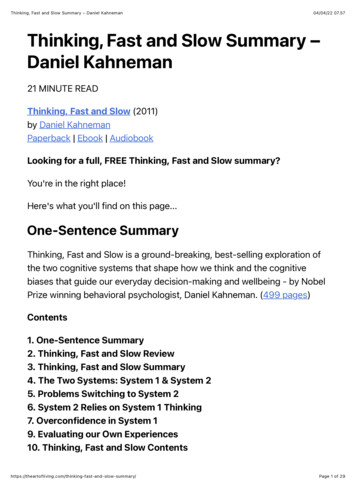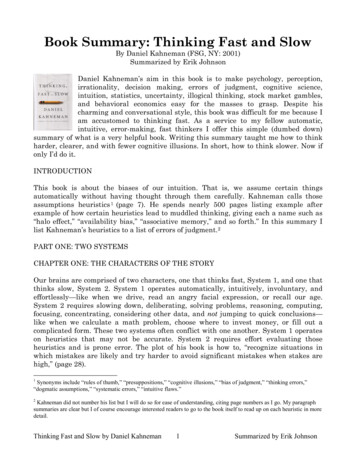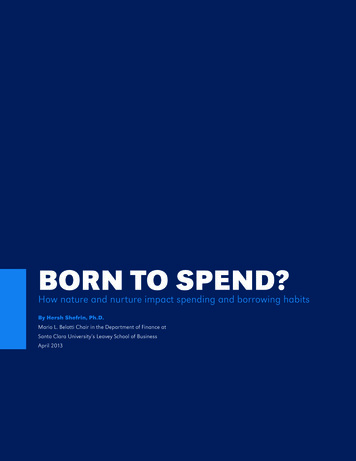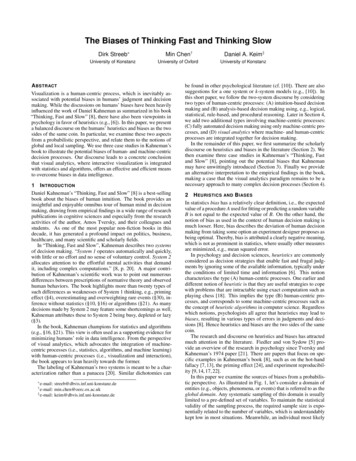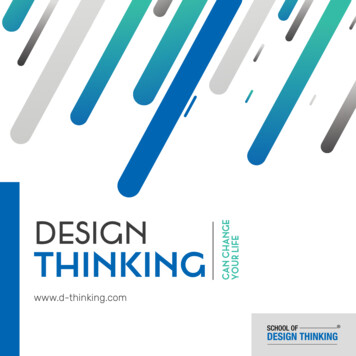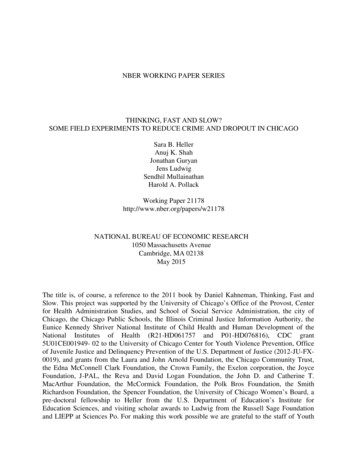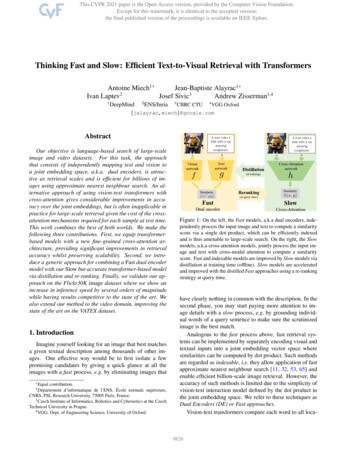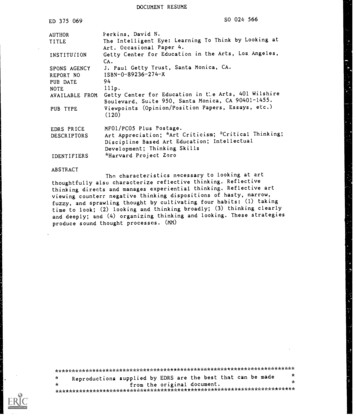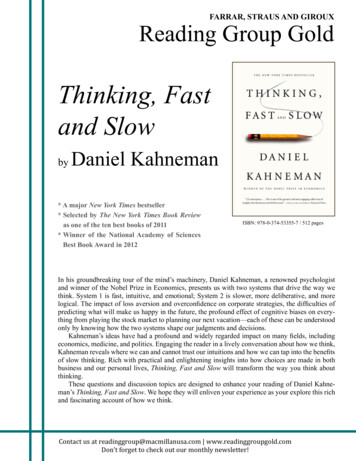
Transcription
FARRAR, STRAUS AND GIROUXReading Group GoldThinking, Fastand SlowbyDaniel Kahneman* A major New York Times bestseller* Selected by The New York Times Book Reviewas one of the ten best books of 2011* Winner of the National Academy of SciencesBest Book Award in 2012ISBN: 978-0-374-53355-7 / 512 pagesIn his groundbreaking tour of the mind’s machinery, Daniel Kahneman, a renowned psychologistand winner of the Nobel Prize in Economics, presents us with two systems that drive the way wethink. System 1 is fast, intuitive, and emotional; System 2 is slower, more deliberative, and morelogical. The impact of loss aversion and overconfidence on corporate strategies, the difficulties ofpredicting what will make us happy in the future, the profound effect of cognitive biases on everything from playing the stock market to planning our next vacation—each of these can be understoodonly by knowing how the two systems shape our judgments and decisions.Kahneman’s ideas have had a profound and widely regarded impact on many fields, includingeconomics, medicine, and politics. Engaging the reader in a lively conversation about how we think,Kahneman reveals where we can and cannot trust our intuitions and how we can tap into the benefitsof slow thinking. Rich with practical and enlightening insights into how choices are made in bothbusiness and our personal lives, Thinking, Fast and Slow will transform the way you think aboutthinking.These questions and discussion topics are designed to enhance your reading of Daniel Kahneman’s Thinking, Fast and Slow. We hope they will enliven your experience as your explore this richand fascinating account of how we think.Contact us at readinggroup@macmillanusa.com www.readinggroupgold.comDon’t forget to check out our monthly newsletter!
FARRAR, STRAUS AND GIROUXReading Group GoldQuestions AND TOPICS for Discussion1. At the opening of Thinking, Fast and Slow, Kahneman discusses the “proverbial office watercooler” as the ideal setting in which readers could use knowledge gained from his book. Why doyou think Kahneman makes a point of mentioning gossip so early on? How do you see his claimsabout the connection between gossip and better decision making playing out in the book and inyour own lives?2. Everyone has his or her favorite “cognitive biases” described in the book. Discuss what you feltwere the most surprising, resonant, suggestive, or memorable of the biases, fallacies, and illusionsthat Kahneman explores. What captured your imagination about these particular ones?3. On the flip side, what did you think were the least persuasive parts of Kahneman’s arguments?What conclusions did you doubt or disbelieve? Were there experiments whose results you questioned?4. Even though Kahneman discusses the “optimistic bias,” he also says, “If you were allowed onewish for your child, seriously consider wishing him or her optimism.” Using this as a jumping-offpoint, discuss what is useful about our cognitive biases. What are the “upsides” to the irrationalthinking we are all sometimes guilty of? Would we be happier if we were free of all our biases?5. The Atlantic has called Kahneman the anti–Malcolm Gladwell. Do you agree? How does Thinking, Fast and Slow compare in argument and approach to other books you may have read abouthuman rationality and behavior?6. Kahneman writes: “I have made much more progress in recognizing the errors of others than myown.” Based on your reading of Thinking, Fast and Slow, what practices, behaviors, or activities do you think we could cultivate to strengthen System 2’s effortful thinking over System’s 1’sautomatic responses? How optimistic are you about the results over time? Which of the biases doyou think would be the most difficult to uproot?7. “Self-help” books are traditionally thought to empower us to take greater control over our ownlives, but Thinking, Fast and Slow also calls into question the limits of our rationality. Do youthink Thinking, Fast and Slow works as a piece of self-help literature? After reading it, do youfeel more or less “in control”?8. As Kahneman explains, systematic biases play a substantial role not only in our own lives, but inthe functioning of groups, businesses, and even societies. Discuss examples from politics, culture,or current affairs that you feel demonstrate certain biases.9. Kahneman’s arguments have been applied widely throughout a variety of industries and disciplines, and many of the cognitive biases (including framing, availability, anchors, and the planning fallacy) have serious implications for professional practice. Can you observe biases—andthe exploitation of those biases—in your professional environment? Would you take advantage ofContact us at readinggroup@macmillanusa.com www.readinggroupgold.comDon’t forget to check out our monthly newsletter!
FARRAR, STRAUS AND GIROUXReading Group Goldthe cognitive biases Kahneman describes in your professional life?10. Kahneman devotes all of Part 3 to examining “overconfidence.” Why does this subject deserveits own section? In what ways is it a concern throughout the book?11. In Part 4, Kahneman discusses the ways we evaluate losses and gains, and concludes that human beings tend to be loss averse. Discuss the examples of these behaviors that he explores, andconsider how much your own thinking about risk and reward has changed as a result. Wouldyou make bets now that you wouldn’t have made before, following his advice to “think like atrader”? Does knowing about the “possibility effect,” for instance, change your attitude towardplaying the lottery or mitigate fears about certain dangerous but rare occurrences like accidents,terrorism, and disease?12. Kahneman writes in the introduction that “[a] recurrent theme of this book is that luck plays alarge role in every story of success.” Discuss the role of luck in Thinking, Fast and Slow, considering especially how it relates to Kahneman’s treatment of the world of business and finance.Do you think Kahneman’s strong emphasis on luck in stories of success and good fortune isjustified?13. Kahneman argues that leaving out prospect theory from most introductory economics textbooksis justified since “[t]he basic concepts of economics are essential intellectual tools, which are noteasy to grasp even with simplified and unrealistic assumptions about the nature of the economicagents who interact in markets. Raising questions about these assumptions even as they are introduced would be confusing, and perhaps demoralizing.” When, if ever, is the appropriate timeto teach students about System 1 and 2? Do you think students should learn about the flaws inthe rational agent model early on in their educations?14. On the last page of his book, Kahneman writes that the “remarkable absence of systematic training for the essential skill of conducting efficient meetings” is one way that decision makingcould be improved in an organization. Using Kahneman’s research, discuss other ways that youthink efficiency and effectiveness might be improved at organizations you deal with regularly.15. Discuss Thinking, Fast and Slow as an intellectual memoir. What do you think made Kahneman’s collaborations—especially with Amos Tversky—successful? What working habits or professional practices of his struck you?16. Kahneman describes his working relationship with Gary Klein and calls it his “most satisfyingand productive adversarial collaboration.” Discuss the benefits and risks of “adversarial collaboration” using examples from your own life and work.17. Discuss the political dimension of this book, considering that Kahneman argues that humans often make choices that go against their self-interest. What implications do you think these claimsand, later, Kahneman’s arguments about happiness and well-being have for policy and governance? Should human beings be “nudged” to make the “right” choices?Contact us at readinggroup@macmillanusa.com www.readinggroupgold.comDon’t forget to check out our monthly newsletter!
FARRAR, STRAUS AND GIROUXReading Group Gold18. Consider the ethical dilemma of the colonoscopy experiments: Should doctors focus on limitingreal-time pain or the memories of pain? In other words, how should we weigh the importanceof our remembering and experiencing selves? Also, discuss Kahneman’s example of the painfuloperation that you will forget about later. Do you share his belief that “I feel pity for my sufferingself but not more than I would feel for a stranger in pain”?19. Kahneman writes, “In normal circumstances . . . we draw pleasure and pain from what is happening at the moment, if we attend to it,” and notes that French and American women spendabout the same amount of time eating, but French women seem to attend to it more keenly andtherefore enjoy it more. How does the issue of attention relate to Kahneman’s arguments aboutSystems 1 and 2, as well as his later arguments about happiness and well-being? Discuss theimplications of these arguments both for the individual and for society.20. Philosophers have long debated what it means to lead a “good life.” In what ways has readingThinking, Fast and Slow affected your understanding of what this might mean? In your view,how important is happiness (however we understand that term) to a “good life”? How importantis behaving rationally? Are they related?21. What questions did Thinking, Fast and Slow leave you with? If you were a scientist working inthis field, what areas would you want to study further?Praise foR Thinking, Fast and Slow“ A major intellectual event . . . The work of Kahneman and Tversky was a crucial pivot point in theway we see ourselves.” —David Brooks, The New York Times“ There have been many good books on human rationality and irrationality, but only one masterpiece.That masterpiece is Daniel Kahneman’s Thinking, Fast and Slow . . . This is one of the greatestand most engaging collections of insights into the human mind I have read.” —William Easterly,Financial Times“ [Thinking, Fast and Slow] is wonderful, of course. To anyone with the slightest interest in theworkings of his own mind it is so rich and fascinating that any summary of it would seem absurd.”—Michael Lewis, Vanity Fair“ I will never think about thinking quite the same. [Thinking, Fast and Slow is] a monumental achievement.” —Roger Lowenstein, Bloomberg Businessweek“ [A] tour de force of psychological insight . . . Thanks to the elegance and force of his ideas, andthe robustness of the evidence he offers for them, he has helped us to a new understanding of ourdivided minds—and our whole selves.” —Christopher F. Chabris, The Wall Street JournalContact us at readinggroup@macmillanusa.com www.readinggroupgold.comDon’t forget to check out our monthly newsletter!
FARRAR, STRAUS AND GIROUXReading Group GoldAbout the AuthorDaniel Kahneman is Eugene Higgins Professor of Psychology Emeritus at Princeton Universityand Professor of Psychology and Public Affairs Emeritus at Princeton’s Woodrow Wilson Schoolof Public and International Affairs. He received the 2002 Nobel Prize in Economic Sciences for hispioneering work with Amos Tversky on decision making.Reading group guide written by Gabriella DoobContact us at readinggroup@macmillanusa.com www.readinggroupgold.comDon’t forget to check out our monthly newsletter!
of slow thinking. Rich with practical and enlightening insights into how choices are made in both business and our personal lives, Thinking, Fast and Slow will transform the way you think about thinking. These questions and discussion topics are designed to enhance your reading of Daniel Kahne-man's Thinking, Fast and Slow. We hope they will .
